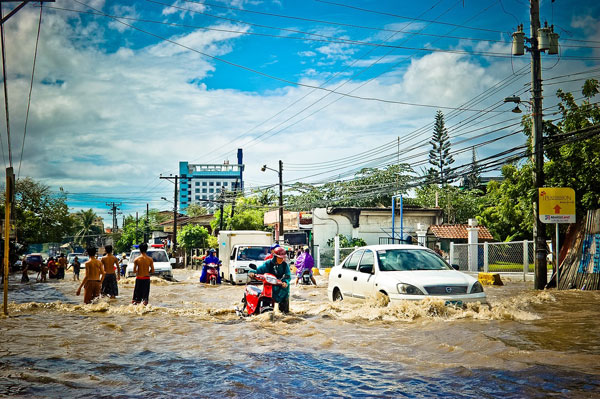Thousands evacuate as floods devastate Indonesia’s capital

[Photo of a flooded village. Photo Credit to Pixabay]
Heavy rains have triggered severe flooding in Jakarta, forcing thousands to evacuate as waters submerged homes, roads, and hospitals.
Authorities warn that heavy rainfall could persist until March 11, potentially worsening the situation.
Floodwaters have reached depths of up to three meters, rendering streets impassable and damaging over 1,000 houses.
Jakarta Governor Pramono Anung has raised the city’s alert level to the second highest, ordering emergency measures including activating water pumps and conducting cloud-seeding operations to mitigate further rainfall.
The floods have inundated five major roads, with water levels ranging from 20 to 100 centimeters.
South Jakarta recorded the highest number of affected units at 42, followed by East Jakarta with 25 and West Jakarta with 10.
Emergency aid efforts are underway, with the Jakarta Disaster Mitigation Agency (BPBD) distributing 1,000 boxes of ready-to-eat meals, 260 childcare packages, 20 cartons of bottled water, 20 blankets, and 160 relief kits for families.
Deputy Governor Rano Karno urged residents in flood-prone areas to consider relocating to government-provided low-cost apartments, also referred to as ‘Rusun’ in Indonesian.
Bekasi, east of Jakarta, is facing some of its worst flooding in years.
Local media reported that floodwaters swamped a hospital, disrupting power and forcing patient evacuations.
Rescue teams are navigating rubber boats through thigh-high water to reach stranded residents, some of whom had been trapped since early morning.
The government has set up temporary shelters in schools, mosques, and churches, where they are distributing food, clothing, and medical aid.
The disaster agency reported ongoing evacuations across Greater Jakarta, which is home to over 30 million people.
Indonesia regularly faces severe flooding, but officials say this is the worst event since 2020.
The devastating floods that year killed over 60 people and displaced 175,000.
Many residents fear a repeat of that catastrophe as torrential rains continue to submerge homes and critical infrastructure.
The flooding, worsened by heavy monsoon rains and tropical cyclones, has left entire neighborhoods without power, forcing thousands to evacuate.
In Bekasi, one of the hardest-hit areas, families anxiously monitor water levels, recalling the chaos of five years ago.
With more rain expected, concerns grow that Jakarta could face another large-scale humanitarian crisis.
Authorities remain on high alert, hoping weather modification efforts can alleviate the crisis before conditions deteriorate further.
Similar concerns are arising in other parts of Southeast Asia.
In late November 2024, Malaysia faced severe flooding that claimed three lives and displaced approximately 95,000 individuals, with the northeastern state of Kelantan being the worst affected.
Severe monsoon floods in East Malaysia have displaced thousands since January 28, 2025, with heavy rainfall and high tides worsening conditions in Sarawak and Sabah.
East Malaysia has further been dealing with devastating monsoon floods since January 28, 2025, leading to the evacuation of over 12,486 people in Sarawak and 5,216 in Sabah.
Authorities have set up relief centers as floodwaters continue to rise, with Bintulu and Kota Marudu among the hardest-hit areas.
Adding to the region’s instability, Bali recorded a significant rise in seismic activity throughout 2024, with 582 earthquakes—an 80% increase from the previous year.
While most quakes were minor, the surge in activity has raised concerns among residents and tourists, emphasizing the need for better disaster preparedness.
With floods ravaging Indonesia and nearby nations, the situation remains dire.
The combination of heavy rainfall, rising water levels, and past tragedies weighs heavily on the minds of residents.
As the region battles extreme weather events, emergency teams and relief efforts remain stretched, highlighting the urgent need for long-term flood prevention strategies and disaster preparedness measures.

- Shinah Youn / Grade 11
- Colburn School

![THE HERALD STUDENT REPORTERS [US]](/assets/images/logo_student_us.png)
![THE HERALD STUDENT REPORTERS [Canada]](/assets/images/logo_student_ca.png)
